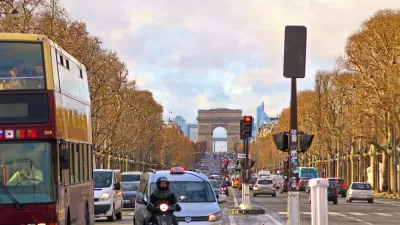As of press time on Friday, the death toll from the Nice Bastille Day massacre is 84, injuries exceeding 200, a record for an act of alleged terrorism committed by a single person. It also sets a record for death by the use of a motor vehicle.

When I initially heard on Thursday afternoon that a truck had caused dozens of deaths at a Bastille Day celebration in Nice, France, and that the truck was laden with weapons and explosives, I thought the media was describing a "truck bomb." As the details of the largest mass murder of people by a single individual were revealed, it was made clear that the main weapon was the truck itself, being driven by someone intent on killing as many innocent civilians as possible.
"Just before the carnage Thursday night, hundreds, if not thousands, had gathered on the promenade to watch a colorful display of fireworks and live music for the national holiday," reports CNN.
"Starting around 10:45 p.m., the attacker mowed down scores of victims in Nice with a rented 19-ton refrigerated truck before engaging in a gunfight with three police officers, who pursued him down a storied seaside promenade before finally killing him," reports The New York Times.
The driver was allegedly Lahouaiej Bouhlel, a 31-year-old French-Tunisian delivery driver "known to the police for assault with a weapon, domestic violence, threats and robbery but had no previous convictions for terrorism," reports The Telegraph.
Motor vehicles intentionally used as deadly weapons
Bouhlel undertook "a tactic authorities have warned about for several years," writes Alex Johnson for NBC News.
As early as December 2010, the U.S. Department of Homeland Security issued an alert to law enforcement warning that "such attacks could be used to target locations where large numbers of people congregate, including sporting events, entertainment venues, or shopping centers."
So-called vehicle ramming is alluring to potential attackers because it offers them an opportunity to conduct strikes without firearms or explosives and with "minimal prior training or experience," DHS said. [Italics added.]
As for firearms and explosives, incredibly, all those initial reports were way off. Other than a handgun, the weapons and explosives were either non-existent or fake, according to CNN.
After Bouhlel was shot, police found a handgun and some ammunition in the truck's cab, as well as a replica handgun, two replica assault rifles, a cell phone and various documents, Molins said. In the trailer was the bicycle and some empty pallets.
Bouhlel was known as someone who biked everywhere, even carrying it up the stairs to his apartment. He used that bicycle to ride to the lorry-rental facility.
Back to the DHS warning about such attacks. Johnson of NBC continues:
The [DHS] bulletin advised officers to be especially alert for "commercial motor vehicles or heavy equipment being operated erratically, at unusual times, or in unusual locations, particularly in heavy pedestrian areas."
Johnson goes on to list examples of vehicles used by individuals as weapons of carnage:
- 1995, San Diego: an army veteran stole a tank, but no fatalities other than himself.
- 2006, North Carolina: Iranian former student used SUV to plow into crowd, no fatalities.
- 2009, Netherlands: potential royal family assassin plows into parade with car, eight fatalities.
- 2014, Saint-Jean-sur-Richelieu, Quebec: "ISIS-inspired" terrorist rams into two Canadian soldiers in the parking lot of a shopping center, one dies.
- 2014, Jerusalem: terrorist slams into a crowd of people at a light rail stop in Jerusalem, killing two.
- 2014, Dijon and Nantes, France: Two men crash their cars into groups of pedestrians on successive days. Eleven people are injured in Dijon, and the next day, one person is killed and nine others are injured in Nantes.
FULL STORY: A Short History of Vehicles Being Used as Deadly Weapons

Planetizen Federal Action Tracker
A weekly monitor of how Trump’s orders and actions are impacting planners and planning in America.

Map: Where Senate Republicans Want to Sell Your Public Lands
For public land advocates, the Senate Republicans’ proposal to sell millions of acres of public land in the West is “the biggest fight of their careers.”

Restaurant Patios Were a Pandemic Win — Why Were They so Hard to Keep?
Social distancing requirements and changes in travel patterns prompted cities to pilot new uses for street and sidewalk space. Then it got complicated.

Platform Pilsner: Vancouver Transit Agency Releases... a Beer?
TransLink will receive a portion of every sale of the four-pack.

Toronto Weighs Cheaper Transit, Parking Hikes for Major Events
Special event rates would take effect during large festivals, sports games and concerts to ‘discourage driving, manage congestion and free up space for transit.”

Berlin to Consider Car-Free Zone Larger Than Manhattan
The area bound by the 22-mile Ringbahn would still allow 12 uses of a private automobile per year per person, and several other exemptions.
Urban Design for Planners 1: Software Tools
This six-course series explores essential urban design concepts using open source software and equips planners with the tools they need to participate fully in the urban design process.
Planning for Universal Design
Learn the tools for implementing Universal Design in planning regulations.
Heyer Gruel & Associates PA
JM Goldson LLC
Custer County Colorado
City of Camden Redevelopment Agency
City of Astoria
Transportation Research & Education Center (TREC) at Portland State University
Camden Redevelopment Agency
City of Claremont
Municipality of Princeton (NJ)




























